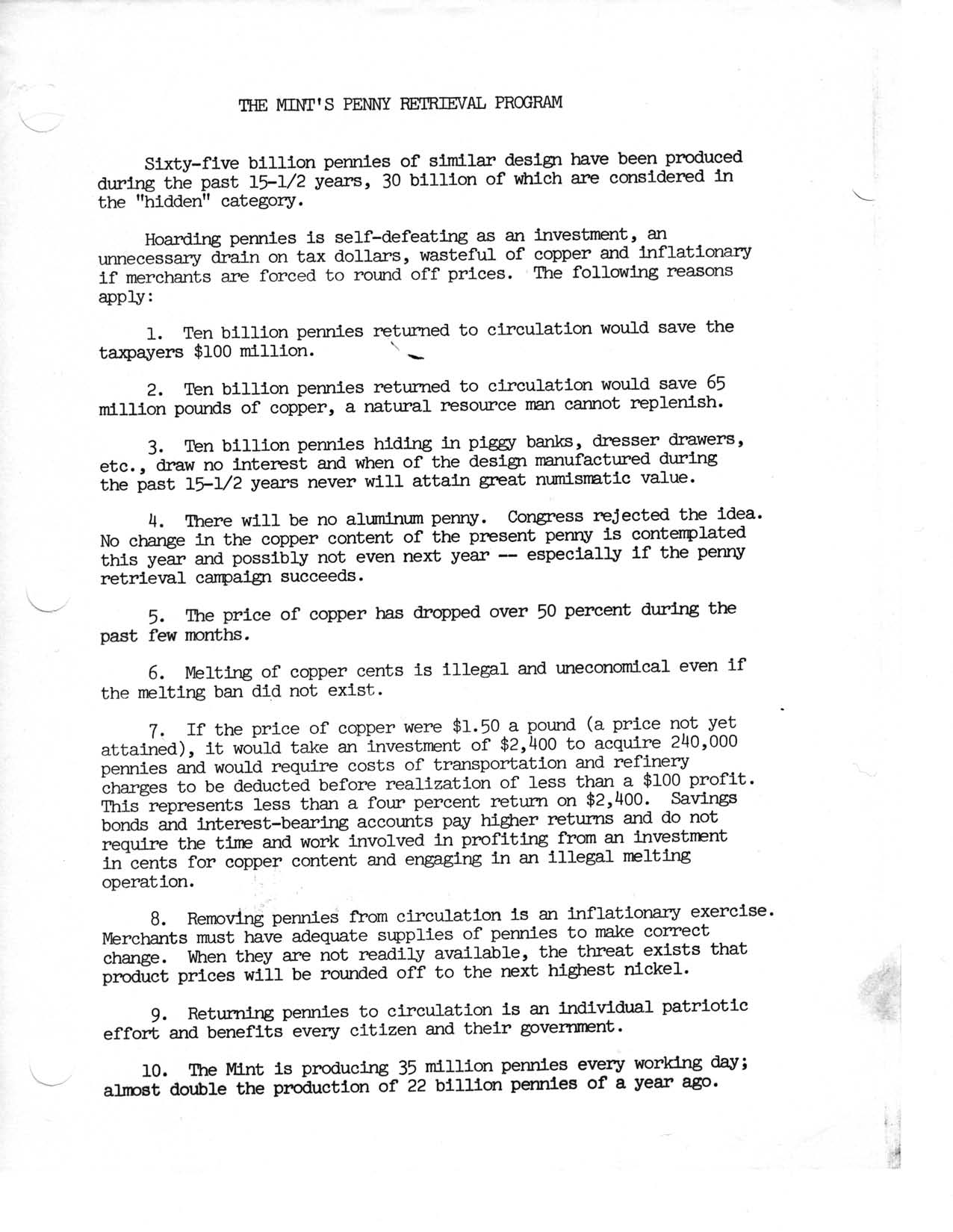Press Release
June 11, 1974
Mrs. Gerald R. Ford, wife of the Vice President, and Mrs. Arthur Burns, wife of the Chairman of the Federal Reserve System, are going to help relieve the penny pinch, Mrs. Mary Brooks, Director of the Mint, announced today.
June is Penny Redemption Month and banks throughout the nation are cooperating in the national campaign to return the penny to circulation.
Mrs. Ford and Mrs. Burns will be turning in their pennies on Friday, June 14, 1974, at 11:00 a.m. at the National Savings and Trust Company, 15th and New York Avenue, N.W., Washington, D.C.
Individuals or groups turning in $25 or more in pennies for deposit or exchange to any participating bank or retail establishment will receive a Special Citation from the Treasury Department for patriotically responding to the penny drive.
One billion pennies returned to circulation will save the taxpayers $10 million. During the past 15 years alone, the Mint has pumped out 70 billion pennies, 30 billion of which are thought to be languishing away in piggy banks, pickle jars, old socks, and what have you. Mrs. Ford will bring in her pennies in the container in which she found them.
The Mint’s Penny Retrieval Program
Sixty-five billion pennies of similar design have been produced during the past 15-1/2 years, 30 billion of which are considered in the “hidden” category.
Hoarding pennies is self-defeating as an investment, an unnecessary drain on tax dollars, wasteful of copper and inflationary if merchants are forced to round off prices. The following reasons apply:
- Ten billion pennies returned to circulation would save the taxpayers $100 million.
- Ten billion pennies returned to circulation would save 65 million pounds of copper, a natural resource man cannot replenish.
- Ten billion pennies hiding in piggy banks, dresser drawers, etc., draw no interest and when of the design manufactured during the past 15-1/2 years never will attain great numismatic value.
- There will be no aluminum penny. Congress rejected the idea. No change in the copper content of the present penny is contemplated this year and possibly not even next year—especially if the penny retrieval campaign succeeds.
- The price of copper has dropped over 50 percent during the past few months.
- Melting of copper cents is illegal and uneconomical even if the melting ban did not exist.
- If the price of copper were $1.50 a pound (a price not yet attained), it would take an investment of $2,400 to acquire 240,000 pennies and would require costs of transportation and refinery charges to be deducted before realization of less than a $100 profit. This represents less than a four percent return on $2,400. Savings bonds and interest-bearing accounts pay higher returns and do not require the time and work involved in profiting from an investment in cents for copper content and engaging in an illegal melting operation.
- Removing pennies from circulation is an inflationary exercise. Merchants must have adequate supplies of pennies to make correct change. When they are not readily available, the threat exists that product prices will be rounded off to the next highest nickel.
- Returning pennies to circulation is an individual patriotic effort and benefits every citizen and their government.
- The Mint is producing 35 million pennies every working day; almost double the production of 22 billion pennies of a year ago.




